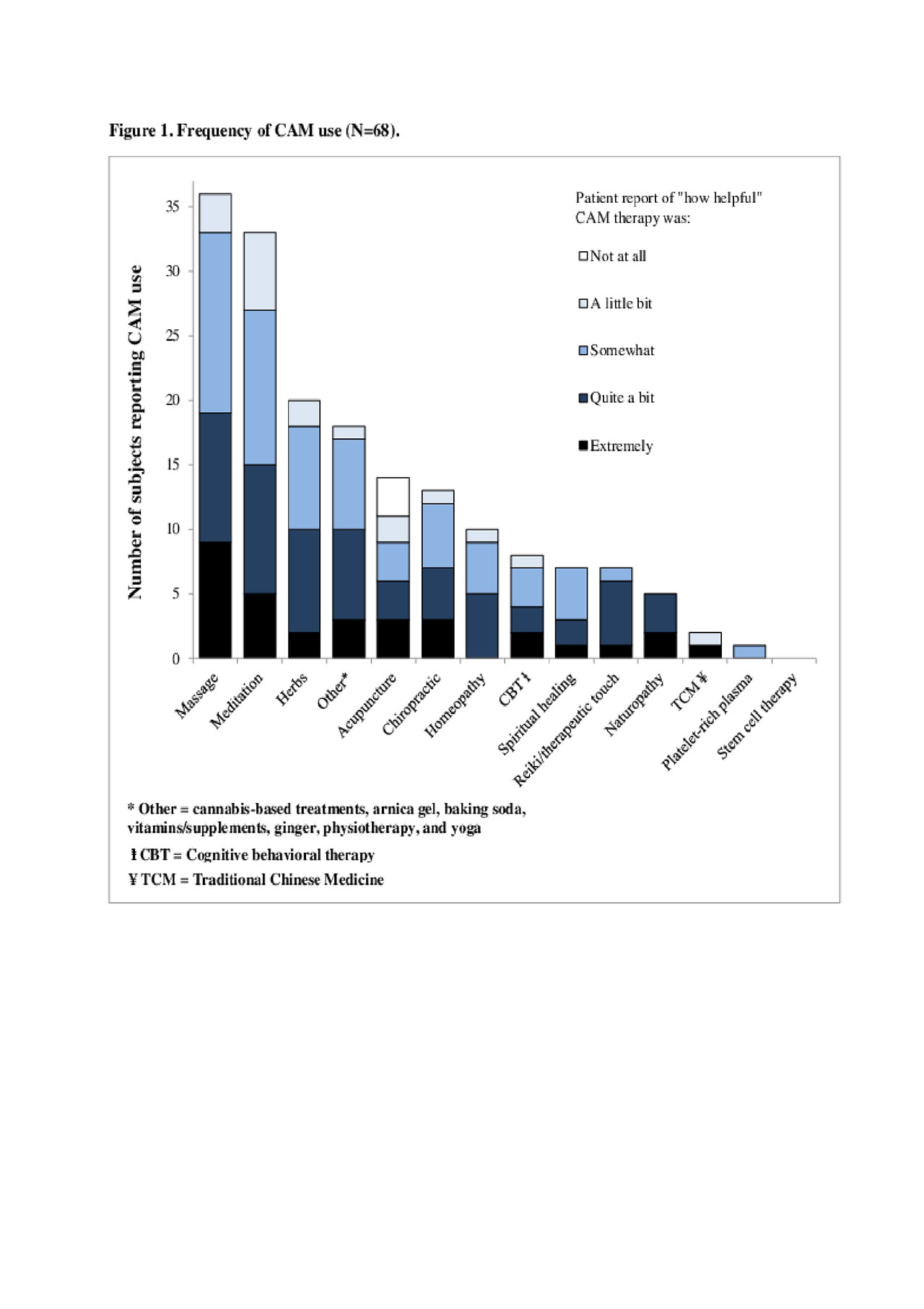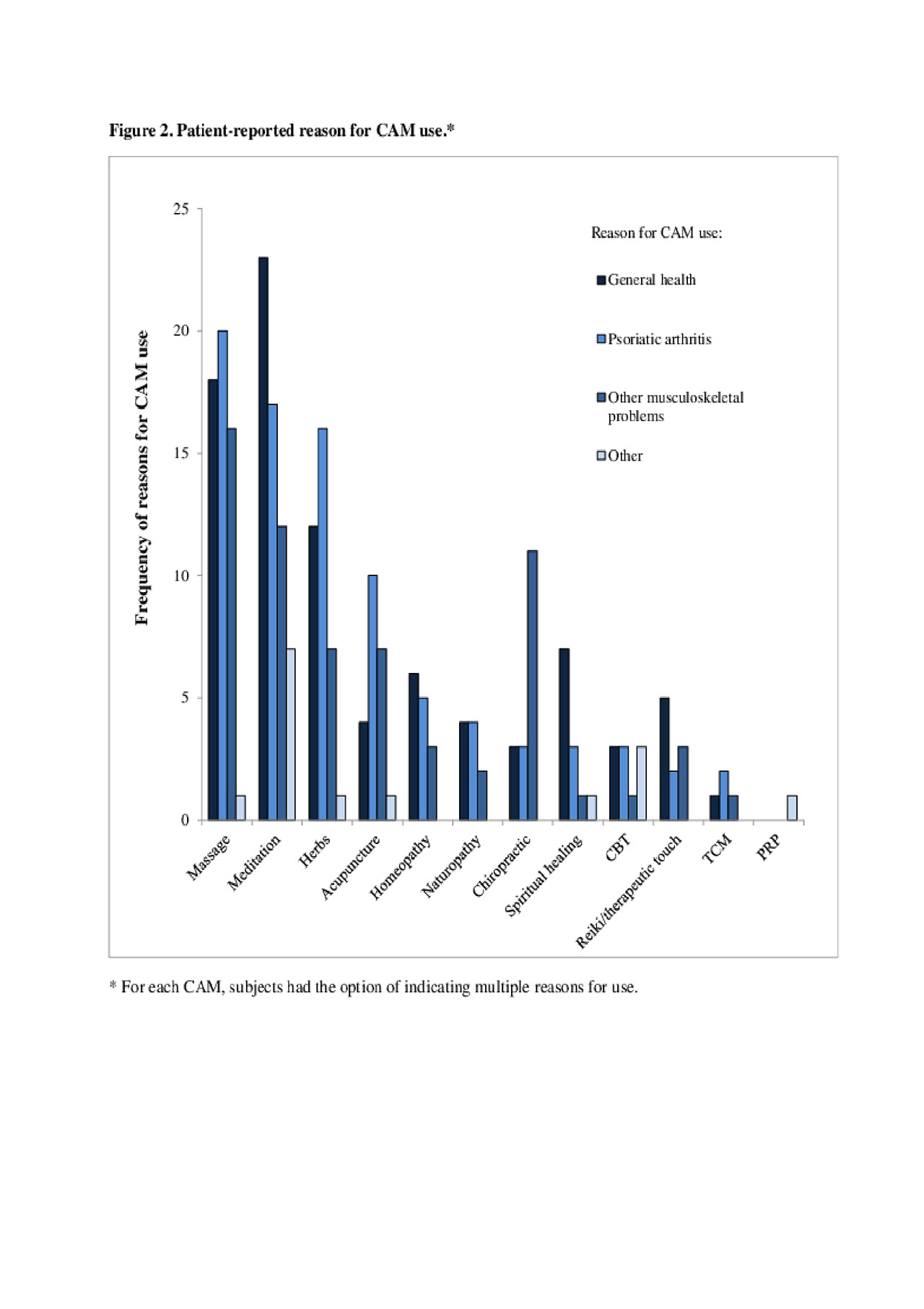Session Information
Session Type: Poster Session (Tuesday)
Session Time: 9:00AM-11:00AM
Background/Purpose: Approximately one third of people in the United States use complementary and alternative medicines. While there is published data on the use of CAM in the general population and some disease states, use in patients with psoriatic arthritis (PsA) has not been explored in detail. In this study we evaluated CAM use in an institutional cohort of validated PsA patients.
Methods: PsA patients seen at a single center between January 1, 2013 and December 31, 2017 were identified using ICD-9 and ICD-10 codes. Of those patients identified, patients who met CASPAR classification criteria were enrolled, and current biologic therapies and targeted synthetics were abstracted from chart review. All patients with available email addresses were surveyed regarding their use of CAM in the last 12 months, reason for CAM use, and helpfulness of CAM use. Patients were asked about specific commonly used complementary and alternative medicine treatments, based on literature review. A Wilcoxon rank-sum test was used to compare median age between CAM and non-CAM users. Pearson’s chi-squared tests were used for sex and race, and a Fisher’s exact test was used to compare biologic and/or targeted synthetic medication use among CAM and non-CAM users.
Results: 328 subjects were sent the questionnaire, and the response rate was 39.3% (129/328). 53% had used CAM in the last 12 months (Figure 1). CAM users were younger: 58 years vs. 63 years (p-value: 0.057), and more likely to be female: 64.7% vs 37.7% (p-value: 0.002). There was no association between race and CAM use (p-value: 0.74). The most popular CAMs used were massage, meditation, and herbs. Reasons for use of CAMs: 34.0% for PsA, 34.4% for general health, 25.6% for other musculoskeletal problems, and 6.0% for other reasons (Figure 2). 26.5% of patients reported using CAM not listed in the questionnaire. These included: cannabis-based treatments, arnica gel, baking soda, vitamins/supplements, ginger, physiotherapy, and yoga.
Overall, 18.4% found CAM use to be extremely helpful; 33.9% quite a bit helpful; 35.6% somewhat helpful; 10.3% a little bit helpful; 1.7% not at all helpful. Although not statistically significant, CAM users were less likely to be on biologics and/or targeted synthetic medications than were non-CAM users (55.9% vs. 70.5%; p-value: 0.26) (Table 1).
Conclusion: CAM use is common in a validated PsA cohort, with more than half of respondents reporting use of at least one type of CAM in the last 12 months. CAM use is more common among those not on biologics/targeted synthetics. Further studies are needed to determine whether CAMs are being used in lieu of standard medications used to treat PsA and if CAM use impacts adherence to traditional therapy.
To cite this abstract in AMA style:
Roberts IV J, Mandl L, Abutalib Z, Schwartzman S. Use of Complementary and Alternative Medicine (CAM) in a Psoriatic Arthritis Cohort [abstract]. Arthritis Rheumatol. 2019; 71 (suppl 10). https://acrabstracts.org/abstract/use-of-complementary-and-alternative-medicine-cam-in-a-psoriatic-arthritis-cohort/. Accessed .« Back to 2019 ACR/ARP Annual Meeting
ACR Meeting Abstracts - https://acrabstracts.org/abstract/use-of-complementary-and-alternative-medicine-cam-in-a-psoriatic-arthritis-cohort/



